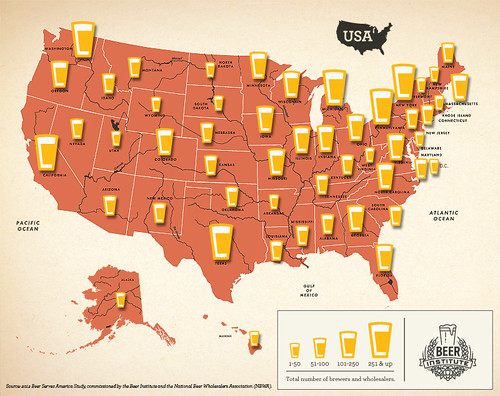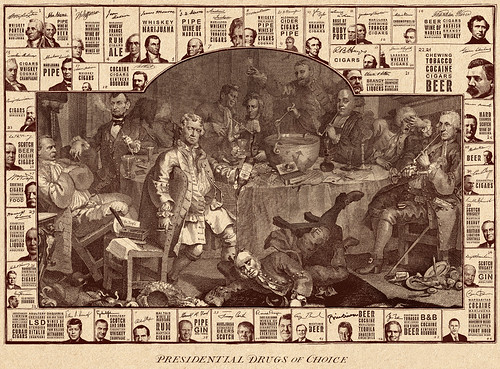
Today’s infographic is another map of the U.S. showing the State Beer Excise Tax Rates for each of the fifty states. Using data from 2011, it was created by the Tax Foundation.

Click here to see the map full size.
By Jay Brooks

Today’s infographic is another map of the U.S. showing the State Beer Excise Tax Rates for each of the fifty states. Using data from 2011, it was created by the Tax Foundation.

Click here to see the map full size.
By Jay Brooks

Today’s infographic is an interactive map of the country created by the Beer Institute for their Beer Serves America, which used to be a separate website, but has since been folded back into the BI website. In the interactive map, holding the cursor over the pint glass in each state bring up additional data about that state, and provides a link to a pdf with much information about the economic impact of beer for each state.

Click here to see the interactive map full size … and interacting.
By Jay Brooks

Today’s infographic is part three of three, created by Floating Sheep in 2010, using data collected in 2008. It’s from a post entitled the Beer Belly of America. The third map shows a more normalized version of yesterday’s map, showing the “relative mentions of bars in the Google Maps directory,” which was accomplished using the average number of bar mentions.
By Jay Brooks

Today’s infographic is part two of three, created by Floating Sheep in 2010, using data collected in 2008. It’s from a post entitled the Beer Belly of America. The second map shows the “absolute mentions of bars in Google Maps directory.” Essentially it shows the location of every bar in America, and where the concentration of them is throughout the country.
By Jay Brooks

Today’s infographic is part one of three, created by Floating Sheep in 2010, using data collected in 2008. It’s from a post entitled the Beer Belly of America. The first map shows geographic references to bars vs. grocery stores, and where (in red) the bars are mentioned more frequently (and then they compared census data, which corroborated their findings).

Click here to see the map full size.
By Jay Brooks

Today’s infographic comes from an Atlantic article on The Geography of Bars and Restaurants. The map uses data from the 2012 census and county business patterns. According to their data, New Orleans has the most bars per households, and San Francisco ranked 8th, with 6 bars for every 10,000 people. It’s also hard to see because the map is relatively small, but there’s a high-density bar area in Northern California in what I believe is Mendocino County.
And while I was mostly interested in the bars, the restaurant data is quite interesting, as well. San Francisco ranked #1 for restaurants per household, with 39.3 per 10,000 residents. That’s roughly one restaurant for every 255 persons.

Click here to see the map full size (and sorry that’s as big as it gets).
By Jay Brooks

Today’s infographic is entitled A Beer Tour Of America, showing their choices for the top ten brewery tours you should take. It was created by Travel Insurance, which describes itself as a “comprehensive online resource for travelers and people looking for more information on travel insurance.”

Click here to see the infographic full size.
By Jay Brooks
![]()
Today’s infographic, in honor of Independence Day, is entitled Presidential Drugs of Choice, showing each out U.S. Presidents favorite alcohol, tobacco or other pleasures. It was originally part of a Kickstarter campaign by Turncoat Wine. It shows each president and then lists their preferences, of which a dozen list beer as one of their favorites.

Click here to see the poster full size.
By Jay Brooks

As Mississippi’s ban on homebrewing was lifted today, for the first time since Prohibition made brewing illegal in 1919, homebrewing is finally allowed in all fifty states. My only comment is it’s about damn time. That a supposed clerical error — a typo — made home winemaking legal after prohibition ended while keeping homebrewing illegal is the biggest anti-alcohol bullshit move of all-time, especially when you consider it took a full seventy years to correct that “typo,” at least for all states. The American Homebrewers Association released a statement this morning, as did the Brewers Association:
Unifying the United States homebrew community has long been an aspiration of the American Homebrewers Association (AHA), and we are proud to announce this goal has been achieved with the help of countless dedicated homebrewers and AHA members like you. July 1, 2013 marks the day Mississippi lifts its homebrew restriction, unifying homebrewers in all fifty states for the first time since before prohibition.
Beer history in the United States region predates the very existence of the country as we know it. Native peoples of the Western Hemisphere produced a watery maize-beer, a pre-cursor to modern American adjunct beer, and as the earliest explorers settled down in the New World, America’s contemporary brewing culture was born.
“From our nation’s founders to our current President, this country has a long and storied tradition of homebrewing,” said AHA director Gary Glass.
Even after prohibition was eradicated with the implementation of the 21st Amendment in 1933, homebrewers would still be criminals in the eyes of the federal law for over four-and-a-half decades. President Jimmy Carter signed a bill that went into effect on February 1, 1979 federally legalizing homebrewing, but it remained up to each state to determine their individual alcohol policies, including home beer production. Over the course of the next forty-six years, states adopted legislation, permitting the making of beer at home.
It’s terrific news that finally homebrewing is permitted in every state. It’s been a long time coming.

By Jay Brooks

Today’s infographic shows a map of the U.S. that’s been color-coded to show beer consumption by state. It was created by Beer Universe in a post entitled Craft Beer in the US: Creativity Across the Map, and although the data is from 2010, I suspect it’s still reasonably accurate for today, as well.

Click here to see the map full size.
